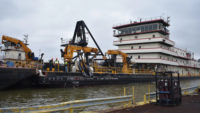Barging along the Mississippi, Colbert said, is “challenged” when the draft level drops to eight feet and “virtually shut down” when it drops to seven feet.
Low water levels in the middle Mississippi “slowed us down, just like they've affected everyone” who barges aggregate and other materials on the river, said Steve Glenn, manager at the Cape Girardeau, Mo., office of Columbia, Ill.-based Luhr Brothers, which owns a network of rock yards, barges and towboats.
Glenn noted that, for example, the Corps’ rock-removal work at Thebes left that section of the river open to barges only eight hours a day. However, companies like his have been finding ways to deal with the situation, he added.
One of the biggest construction projects in the middle Mississippi region—the $346-million Interstate 70 bridge over the river at St. Louis and $321 million in nearby approach and interchange work—has not been affected in a major way by the low water levels, said Greg Horn, New Mississippi River Bridge director at the Missouri Dept. of Transportation.
Horn said, “We were flooded out in 2010,” delaying for three months early work on the bridge project. He said most of the aggregate used in the span has been quarried locally and delivered by truck; for the most part, steel for the project has been trucked in from Arkansas. “We couldn’t float some things in, like we had hoped,” Horn noted, but that only required a different delivery approach, not a delay in work.
Water levels in the lower Mississippi—south of Cairo—are somewhat higher, and the situation less touch-and-go. “We saw [the drought] coming … and built up our stockpiles” of aggregate and other construction materials, said Jimmy Gunter, aggregates manager at Terral RiverServices, a bulk material handling company based in Lake Providence, La.
In part because of that advance planning, “I don’t know of any company that ran out of rock or couldn’t get it” because of lower water levels on the lower Mississippi, though some harbors along the river for a time became unnavigable and needed dredging, Gunter said.
River-watchers hope the worst is over. However, the Corps' Petersen said there is “no guarantee” that water levels will rise as they usually do in late January. “You can't really predict the weather. ... We’re not out of the woods yet, by any means,” he said.






Post a comment to this article
Report Abusive Comment